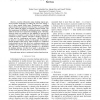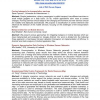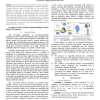MDM
2010
Springer
14 years 5 months ago
2010
Springer
Abstract—Location obfuscation using cloaking regions preserves location anonymity by hiding the true user among a set of other equally likely users. Furthermore, a cloaking regio...
MDM
2010
Springer
14 years 5 months ago
2010
Springer
—Current smartphones have a storage capacity of several gigabytes. More and more information is stored on mobile devices. To meet the challenge of information organization, we tu...
MDM
2010
Springer
14 years 5 months ago
2010
Springer
—VANETs have been envisioned as an infrastructure for deploying Vehicular Information Systems (VIS) that among others provide drivers with an up-to-date view on the prevailing tr...
MDM
2010
Springer
14 years 5 months ago
2010
Springer
—Range query processing is an important technology in spatial databases. Current studies mainly focus on range queries in outdoor space based on the Euclidean or network distance...
MDM
2010
Springer
14 years 5 months ago
2010
Springer
MDM
2010
Springer
14 years 5 months ago
2010
Springer
— People’s location histories imply the location correlation that states the relations between geographical locations in the space of human behavior. With the correlation, we c...
MDM
2010
Springer
14 years 5 months ago
2010
Springer
—The support of distributed atomic transactions in mobile ad-hoc networks (MANET) is a key requirement for many mobile application scenarios. Atomicity is a fundamental property ...
MDM
2010
Springer
14 years 5 months ago
2010
Springer
—Location information is necessarily uncertain when objects are constantly moving. The cost can be high to maintain precise locations at the application server for all the object...
MDM
2010
Springer
14 years 5 months ago
2010
Springer
Abstract—Data-based agreement is increasingly used to implement traceable coordination across mobile entities such as adhoc networked (autonomous) vehicles. In our work, we focus...



